![]()
![]()
![]()
Use LEFT and RIGHT arrow keys to navigate between flashcards;
Use UP and DOWN arrow keys to flip the card;
H to show hint;
A reads text to speech;
55 Cards in this Set
- Front
- Back
- 3rd side (hint)
|
What are the two parts of a typical vertebra? |
Body Vertebral arch |
|
|
|
The typical vertebra has what number of processes? Name them |
7 2 superior articulating processes 2 inferior articulating processes 1 spinous process 2 transverse processes |
|
|
|
The articulation between two vertebral bodies is called the __________; is occupied by the __________, and is classified as a __________ joint. |
Intervertebral articulation Intervertebral disc Amphiarthrodial |
|
|
|
Articulations formed between adjacent superior and inferior articular processes are termed__________ and are classified as __________ joints. |
Zygapophyseal articulations Diarthrodial |
|
|
|
Adjacent vertebral notches form the __________. |
Intervertebral foramina |
|
|
|
The vertebral body connects with its vertebral arch by way of the __________; the upper and lower portions of this structure are called the __________. |
Pedicles Vertebral notches |
|
|
|
Vertebral lamina unite posteriorly to form the __________. |
Spinous process |
|
|
|
Thoracic vertebrae are unique in that they provide rib articulation at the vertebra's __________ and __________. |
Body Transverse processes |
|
|
|
Name the two parts, outer and inner, of the intervertebral disc. |
Annulus fibrosus (outer) Nucleus pulposus (inner) |
|
|
|
What is the medical term for slipped disc? |
Herniated nucleus pulposus (HNP) |
|
|
|
What is the unique characteristic of cervical spinous processes? Of cervical transverse processes? |
Spinous processes are bifid Transverse processes each have a transverse foramen |
|
|
|
Cervical intervertebral foramina are _________ degrees to the MSP and __________ degrees to the transverse plane. |
45° 15° to 20° |
|
|
|
A vertebral foramen is bounded anteriorly by the __________ and posteriorly by the __________. |
Vertebral body Vertebral arch |
|
|
|
What bony structure articulates with the posterior aspect of the anterior arch of C1? |
The odontoid process/dens |
|
|
|
With what structures do the superior articular facets of the atlas/C1 articulate? What is the name of the articulation? |
Occipital condyles Occipitoatlantal articulation |
|
|
|
With what two thoracic vertebra structures do the ribs articulate? |
Body Transverse processes |
|
|
|
The thoracic zygapophyseal articulations are __________ degrees to the MSP and __________ degrees to the MCP. |
15 to 20 70 to 75 |
|
|
|
The articulation between C1 and C2 is termed __________ and is classified as a __________ joint. |
Atlantoaxial joint Diarthrodial |
|
|
|
Which cervical vertebra has no body and no spinous process? Which has an extra long spinous process? |
C1 C7 |
|
|
|
Which positions will demonstrate cervical intervertebral foramina closest to the image receptor? |
RAO and LAO |
|
|
|
Which position will demonstrate cervical zygapophyseal joints to best advantage? |
Lateral |
|
|
|
Inflammation of one or more vertebrae is termed __________. |
Spondylosis |
|
|
|
The AP axial projection of the cervical spine requires tube angulation in what direction and by how many degrees? |
15° to 20° cephalad |
|
|
|
What should be the relationship between the MSP and the IR in the posterior oblique position of the cervical spine? |
45° |
|
|
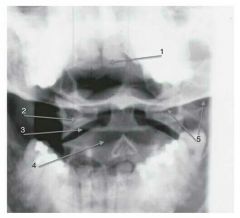
Referring to this image, what two positioning changes should be made? Identify the anatomy indicated in this image. |
Bring head forward Rotate to the left 1. Maxillary incisors 2. Lateral mass C1 3. Atlantoaxial articulation 4. Body of C2 5. Base of skull |
|
|
|
Forward displacement of one vertebra upon the one beneath it is termed __________. |
Spondylolisthesis |
|
|
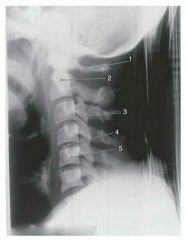
In what position was this image most likely made? Identify the anatomic parts labeled in this image. |
Cross-table lateral
1. Posterior arch of C1 2. Body of C2 3. C3-C4 zygapophyseal joint 4. C4-C5 intervertebral joint 5. Body of C5 |
|
|
|
Anterior oblique positions of the thoracic vertebra require that the MSP be _________ degrees to the IR and the MCP be __________ degrees to the IR. |
20° 70° |
|
|
|
RAO and LAO positions of the thoracic spine are performed to demonstrate the zygapophyseal articulations that are __________ to the IR. |
Closer |
Further or closer |
|
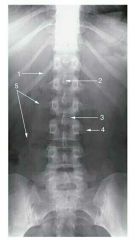
Identify the anatomy indicated in this image. How can the interspace between L5-S1 be better visualized? |
1. Right 12th rib 2. L1 spinous process 3. L2-L3 intervertebral joint 4. L3 transverse process 5. Psoas muscle
Angle the x-ray tube 30° to 35° cephalad |
|
|
|
Which positions will demonstrate lumbar zygapophyseal articulations closest to the image receptor? |
RPO and LPO |
|
|
|
Which position will demonstrate lumbar intervertebral foramina? |
Lateral |
|
|
|
The portion of each lumbar lamina lying between the superior and inferior articular processes is called the __________. |
Pars interarticularis |
|
|
|
The correctly positioned oblique lumbar spine shows the Scottie dog appearance. What bony part does each of the following Scottie dog parts represent: leg, ear, eye, nose, neck. |
Leg: inferior articular process Ear: Superior articular process Eye: pedicle Nose: transverse process Neck: pars interarticularis |
|
|
|
If the lower lumbar spine is not supported so as to be parallel to the IR in the lateral position, the CR should be angled how much and in which direction? |
5° caudad |
|
|
|
Why should a scoliosis series be performed in the PA rather than AP projection? |
To reduce dose to radiosensitive organs |
|
|
|
What positions are generally used to demonstrate spinal fusion? |
Flex/ex lateral |
|
|
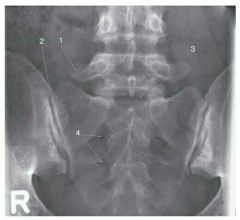
How many degrees, and in what direction, is the x-ray tube directed for this image? Identify the anatomy indicated in this image. |
30° to 35° cephalad 1. L5 transverse process 2. SI joint 3. L5-S1 articulation 4. Sacral foramina |
|
|
|
The LPO and RPO positions of the SI joints visualize which side? How many degrees is the patient rotated? |
The elevated side 25° to 30° |
|
|
|
Where should the CR be directed for the RPO and LPO positions of the SI joints? |
1" medial to the elevated ASIS |
|
|
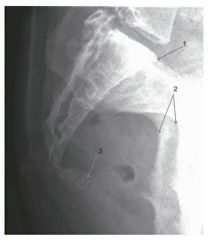
Identify the numbered anatomic parts in the image. |
1. Sacral promontory 2. Greater sciatic notch 3. Coccyx |
|
|
|
What three bones make up the innominate bone of the pelvis? |
Ilium Ischium Pubis |
|
|
|
What bones make up the pelvis? |
Left and right innominate bones Sacrum Coccyx |
|
|
|
The posterior portion of the acetabulum is formed by the __________. |
Ischium |
|
|
|
What portion of what bone extends from the anterior-superior iliac spine to the posterior-superior iliac spine? |
Iliac crest |
|
|
|
The area posterioinferior to the pelvic brim/inlet is called the __________. |
Lesser or true pelvis |
|
|
|
What bones make up the pelvic girdle? |
The two innominate bones |
|
|
|
The superior and inferior rami of the ilium and ischium unite to form the __________. |
Obturator foramen |
|
|
|
The neck of the femur forms a __________ degree angle with its body/shaft. In what direction does the femoral neck also project 15 - 20 degrees? |
120° Anterior |
|
|
|
What is the CR of the bilateral AP oblique (frog leg/modified Cleaves) projection of the pelvis? |
1" superior to the pubic symphysis |
|
|
|
The RPO position for the acetabulum requires what degree will be obliquity? |
45° |
|
|
|
To demonstrate the rami of the pubis and ischium in the AP axial projection, the CR should be directed __________ degrees, in what direction? |
30° to 45° for females, 20° to 35° for males Caudad |
|
|
|
When the body is in the seated upright position, the body's weight rests on what pelvic structures? |
Ischial tuberosities |
|
|
|
How is the femoral neck located in an AP projection of the hip? |
2.5" distal and perpendicular to the midpoint of a line between the ASIS and pubic symphysis |
|
|
|
In the mediolateral projection of the hip, how much is the femur abducted? |
40° to 45° |
|

